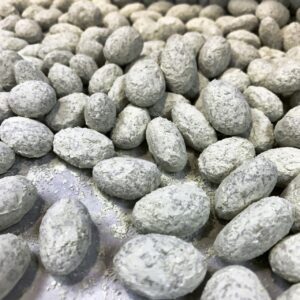In our exclusive feature focusing on glazing, polishing and coating, our Technical Editor, Clay Gordon, investigates the vegan alternatives to shellac, a natural bio adhesive polymer made from the exudate of the female lac bug, Kerria lacca
“How hard can it actually be,” beginning confectioners and chocolate makers have often asked me, “to cover something like nuts with chocolate?”
The answer, like most things when it comes cocoa or chocolate, is, “It depends.” In the abstract, the steps are simple to describe – encapsulate, engross, polish, and glaze. Of course, this deceptive simplicity hides a wide range of technical and process decisions as well as the need for experience in order to become proficient in the techniques. Adding to this complexity are questions around certifications, organic, kosher, and non-GMO for example, and special dietary requirements, including veganism, which are of increasing interest among consumers and retailers these days.
“Hand coating was still the most common technique until the mid-1800s when the introduction of a hand-turned vessel, or pan, began to transform candy making”
While the modern-ish idea of panning may go back to 13th century France with the production of bite-sized items with sweet coatings, apothecaries as far back as the 10th century have coated medicines with substances in order to make them easier to swallow. Hand coating was still the most common technique until the mid-1800s when the introduction of a hand-turned vessel, or pan, began to transform candy making and paved the way for industrialisation. And, while the machinery for panning has steadily increased in sophistication, the basic technique remains largely the same as it has been since its invention.
One aspect of panning that has been resistant to change is the final, or glazing, step. Confectionery glazes seal in the gloss finish created during the immediately prior, polishing, step. Without a glazing sealer the polished finish is quite fragile and is easily scuffed and marred by fingerprints. Resinous confectioners’ glazes are often based on shellac, a natural bio adhesive polymer made from the exudate of the female lac bug, Kerria lacca (also known as Laccifer lacca), which makes shellac decidedly not vegan. For a long time, shellac-based glazes were not considered Kosher, and, depending on how the shellac was processed, were – and still are – not approved for use in organically certified products, either.
“Vegan alternatives to shellac have existed for some time, among them, carnauba wax and products based on zein”
The earliest written evidence for shellac dates to around 1000 BCE and its history demonstrates its flexibility in applications ranging from furniture polish to electrical insulator to an excipient in pharmaceutical production. It’s not entirely clear when shellac was first used in confectionery production, (these days, most shellac is harvested and produced in India and, to a lesser extent in Thailand and other countries in the region), though its use in medical applications, coupled with the fact that apothecaries were among the first chocolate makers, suggests a connection that could date as far back as 16th century Spain.
Vegan alternatives to shellac have existed for some time, among them, carnauba wax and products based on zein, a tasteless, odourless, colourless edible protein that is mechanically extracted from corn. What many people may not realise is that the encapsulation and polishing steps have long been done using plant-based, vegan, products. Encapsulation refers to coating the centre – whatever is going to be coated in chocolate – with a substance that forms a barrier layer that inhibits the migration of moisture, oxygen, and fat between the centre and the chocolate coating. The moisture and oxygen barrier properties of the encapsulation layer increase the shelf-life of finished products by slowing the tendency of a given centre to go rancid or stale. The lipid barrier properties of the encapsulation layer slow the migration of fat between the centre (e.g., nuts such as macadamia are very high fat) and the chocolate. This fat migration can make it more difficult for the chocolate to stick to the centre and can result in fat bloom.
Conventionally, gum arabic in an ethanol solution has been used for the encapsulation layer, though zein-based products, which are applied in an ethanol/water mix, are increasingly common. Different formulations deliver encapsulation layers with very different barrier and adhesive capabilities. For example, there are zein-based encapsulation products that are certified to deliver three-year shelf life at 80F (27C). This performance is required by the US Department of Defence in MRE (meals ready to eat) rations containing nuts.
While shelf-life may be one reason to favour zein-based products over other options in some applications, it is important to take into consideration the actual technical characteristics of the centre to be encapsulated when making this decision. For example, for some centres, adhesive requirements may dictate the selection of a particular encapsulation product which could affect the barrier properties and therefore shelf life. For this reason, it is often helpful to engage with a manufacturer/distributor/consultant who will consider what may be competing requirements to arrive at the best solution for any product.
After encapsulation, the coated centres are allowed to dry thoroughly. Once completely dry, the encapsulated centres are engrossed with chocolate (which does not need to be tempered) in pans or belt coaters. The length of time it takes to finish the engrossing process is dependent on many factors, chief among them the ratio of the weight of the centre to the weight of chocolate. The higher the ratio of chocolate to centre, the longer the engrossing process takes.

Once the engrossing process is complete, the next step is often, though not always, polishing. Polishing creates finished products with surfaces from matte to high gloss; alternatively, powdered sugar, cocoa powder, and other coating options are available as both creative flavouring and visual/textural options. What is important to understand is that the polish finish is quite delicate because the polish is water-based and extremely hygroscopic; the glaze layer, being a moisture barrier, seals and protects it.
For some companies, the choice to go vegan is a simple and straightforward one. For other companies, especially those with established operations, the decision tree is a lot more complex. But, especially among the craft chocolate community, there is a real misunderstanding of the potential ROI panning offers, even when expensive craft chocolate is used. This is because the centres can be quite inexpensive compared with the cost of the chocolate and often comprise 60% or more of the weight of the finished product.
In large part this misunderstanding is based in the fact that shoppers do not think about the price of panned items the same way they evaluate the price of a chocolate bar. For many, £7.99 is too much to pay for a chocolate bar weighing less than 100gr, and especially when much larger bars with sexy social certifications and fancy advertising campaigns with bright wrappers and very fancy moulds can be found on offer for £2.99 or less.
But panned items tend to be offered up in bulk to be weighed at the point of sale or are packed in bags. Consumers think about products priced, packed, and sold that way very differently from chocolate bars – the value proposition is quite different.
“Clean-up after glazing is now much faster than when we used shellacs”
Thus, while there is a learning curve when it comes to becoming really, truly, proficient in panning, and there is an investment in equipment that must be made, the investment can start out quite small with lab-scale pans capable of producing batch sizes on the order of 2-3 kg. This reduces the risk of creating less-than-perfect products while learning and practicing, products that may prove difficult to sell; the small batch size compensates for this. Once the process is mastered, production scale equipment is not that expensive – on the same order as a new 35kg melanger fitting in roughly the same footprint in the factory. This makes panning one of the highest ROI manufacturing methods available to the craft chocolate maker and confectioner who are looking for ways to differentiate themselves from larger manufacturers. And creating vegan products via panning is one such differentiator.
Dallas Southcott, The Chocolate Lab, Canada
Here at The Chocolate Lab we only recently started using a full zein-based solution for encapsulating, polishing, and glazing, and a primary motivation for doing so was a desire to move to a vegan confectioner’s glaze.
As with virtually all process changes there was a learning curve, but the differences were not too great and adapting to the differences did not take us very long. Importantly, there was no compromise in the quality of the finished pieces from a visual or taste perspective. The biggest surprise to us is that clean-up after glazing is now much faster than when we used shellacs. We’re not exactly sure why that is, but anything that can save us time in cleaning up shows up directly on the bottom line, so that’s an added bonus we hadn’t considered.
One area for future experimentation is to see how zein-based products can be used in other areas of our production, which includes a wide range of shell-moulded bonbons. One use we’re considering is misting the interior of shells before filling them with some of our higher water activity centres. This should greatly improve the rather poor oxygen barrier that is the chocolate shell, extending shelf life at room temperature. The moisture barrier properties will reduce the possibility for the water to damage the integrity of the chocolate shell, while the fat barrier properties mean that with high-fat centres like nut pralines we have less to worry about when it comes to fat migration and bloom. We’re also excited to start experimenting with using the zein encapsulation product to extend the shelf life of some of the very hygroscopic cooked sugar products we cook.
David Jordan, Director, Technical Sales and Services, Centerchem, Inc., USA
For many of our clients here at Centerchem, it’s not a question of, ‘Are vegan plant-based glazes always a better choice than shellac-based glazes?’ Factors include ‘Is the market demanding the switch and what changes will be required, if any, on the production line – what impact will it have on existing processes or procedures?’ In the end, sometimes the answer is, it’s always been shellac; from the beginning that’s what the customer has been using. It’s the norm, and if something works, well, if it isn’t broken, then don’t break it. If there’s a way, or a system, or a process, then people stay with it and trying to modify that is often challenging.
It also often comes down to economies of scale. The companies that have traditionally used the zein-based glazes, have, to date, tended to be smaller users. When working with smaller volumes costs are typically higher, but in larger-volume applications the costs are similar. A decision to switch is often driven by other considerations, one of which might be a demand from customers for vegan options, but it could also include a reassessment of a specific product’s carbon footprint, the company’s overall carbon footprint, or other sustainability issues. When comparing the total impact – social, environmental, process, and economic – of a locally-sourced zein-based product compared with a shellac shipped from halfway around the world, the economics can tip in favour of a zein-based solution.
Certifications can also play a role. Shellac, though it is derived from insects, is, surprisingly to many, considered Kosher by many major Kosher certification agencies, but not all of them, so its use may depend on the specific customer-base a product is being sold into. When it comes to organic certification there are some grades of shellac, generally unbleached varieties, that the USDA recognizes can be used in organically certified products. Some grades are not so it’s important to check with the manufacturers, and the specific guidance may change in other countries so something the USDA considers organic might not be accepted by other organic certifiers, which could have an impact on products marketed and sold internationally.
Rachel Freedman, President, FloZein Products, USA
While our customers often cite that they prefer Zein over shellac due to its being a vegan alternative, there are several other environmental benefits to both Zein and the processes we use to produce it. Zein is manufactured from corn, a renewable resource. In addition, Zein is compostable and biodegradable, and releases no harmful by-products into the soil. The corn gluten meal from which Zein is extracted is a by-product of the wet milling of corn, which primarily produces corn germ and corn starch, while the gluten meal is used primarily for animal feed. Flo extracts the Zein from the corn gluten meal, and then returns the spent gluten to the feed market. There is zero waste.
Zein has proven to be highly effective in the encapsulation and glazing of confectionery products. We are now exploring extending its use in food and confectionery packaging. Zein is a highly effective moisture barrier. In addition, when combined with paperboard, it provides a highly effective and biodegradable alternative to wax and other additives. Zein also has demonstrated natural anti-microbial properties which makes it ideal for food packaging.
Because consumers are increasingly knowledgeable about clean label products and healthier eating, Zein enables manufacturers to meet those demands in cost-effective and environmentally beneficial ways.
To stay up to date on the latest, trends, innovations, people news and company updates within the global confectionery market please register to receive our newsletter here
Media contact
Roshini Bains,
Editor, International Confectionery
Tel: +44 (0) 1622 823 922
Email: [email protected]









